Kun Sun
SentinelAgent: Graph-based Anomaly Detection in Multi-Agent Systems
May 30, 2025Abstract:The rise of large language model (LLM)-based multi-agent systems (MAS) introduces new security and reliability challenges. While these systems show great promise in decomposing and coordinating complex tasks, they also face multi-faceted risks across prompt manipulation, unsafe tool usage, and emergent agent miscoordination. Existing guardrail mechanisms offer only partial protection, primarily at the input-output level, and fall short in addressing systemic or multi-point failures in MAS. In this work, we present a system-level anomaly detection framework tailored for MAS, integrating structural modeling with runtime behavioral oversight. Our approach consists of two components. First, we propose a graph-based framework that models agent interactions as dynamic execution graphs, enabling semantic anomaly detection at node, edge, and path levels. Second, we introduce a pluggable SentinelAgent, an LLM-powered oversight agent that observes, analyzes, and intervenes in MAS execution based on security policies and contextual reasoning. By bridging abstract detection logic with actionable enforcement, our method detects not only single-point faults and prompt injections but also multi-agent collusion and latent exploit paths. We validate our framework through two case studies, including an email assistant and Microsoft's Magentic-One system, demonstrating its ability to detect covert risks and provide explainable root-cause attribution. Our work lays the foundation for more trustworthy, monitorable, and secure agent-based AI ecosystems.
ChainMarks: Securing DNN Watermark with Cryptographic Chain
May 08, 2025Abstract:With the widespread deployment of deep neural network (DNN) models, dynamic watermarking techniques are being used to protect the intellectual property of model owners. However, recent studies have shown that existing watermarking schemes are vulnerable to watermark removal and ambiguity attacks. Besides, the vague criteria for determining watermark presence further increase the likelihood of such attacks. In this paper, we propose a secure DNN watermarking scheme named ChainMarks, which generates secure and robust watermarks by introducing a cryptographic chain into the trigger inputs and utilizes a two-phase Monte Carlo method for determining watermark presence. First, ChainMarks generates trigger inputs as a watermark dataset by repeatedly applying a hash function over a secret key, where the target labels associated with trigger inputs are generated from the digital signature of model owner. Then, the watermarked model is produced by training a DNN over both the original and watermark datasets. To verify watermarks, we compare the predicted labels of trigger inputs with the target labels and determine ownership with a more accurate decision threshold that considers the classification probability of specific models. Experimental results show that ChainMarks exhibits higher levels of robustness and security compared to state-of-the-art watermarking schemes. With a better marginal utility, ChainMarks provides a higher probability guarantee of watermark presence in DNN models with the same level of watermark accuracy.
A Knowledge-enhanced Pathology Vision-language Foundation Model for Cancer Diagnosis
Dec 17, 2024Abstract:Deep learning has enabled the development of highly robust foundation models for various pathological tasks across diverse diseases and patient cohorts. Among these models, vision-language pre-training, which leverages large-scale paired data to align pathology image and text embedding spaces, and provides a novel zero-shot paradigm for downstream tasks. However, existing models have been primarily data-driven and lack the incorporation of domain-specific knowledge, which limits their performance in cancer diagnosis, especially for rare tumor subtypes. To address this limitation, we establish a Knowledge-enhanced Pathology (KEEP) foundation model that harnesses disease knowledge to facilitate vision-language pre-training. Specifically, we first construct a disease knowledge graph (KG) that covers 11,454 human diseases with 139,143 disease attributes, including synonyms, definitions, and hypernym relations. We then systematically reorganize the millions of publicly available noisy pathology image-text pairs, into 143K well-structured semantic groups linked through the hierarchical relations of the disease KG. To derive more nuanced image and text representations, we propose a novel knowledge-enhanced vision-language pre-training approach that integrates disease knowledge into the alignment within hierarchical semantic groups instead of unstructured image-text pairs. Validated on 18 diverse benchmarks with more than 14,000 whole slide images (WSIs), KEEP achieves state-of-the-art performance in zero-shot cancer diagnostic tasks. Notably, for cancer detection, KEEP demonstrates an average sensitivity of 89.8% at a specificity of 95.0% across 7 cancer types. For cancer subtyping, KEEP achieves a median balanced accuracy of 0.456 in subtyping 30 rare brain cancers, indicating strong generalizability for diagnosing rare tumors.
Dspy-based Neural-Symbolic Pipeline to Enhance Spatial Reasoning in LLMs
Dec 12, 2024Abstract:Large Language Models (LLMs) have demonstrated remarkable capabilities across various tasks, yet they often struggle with spatial reasoning. This paper presents a novel neural-symbolic framework that enhances LLMs' spatial reasoning abilities through iterative feedback between LLMs and Answer Set Programming (ASP). We evaluate our approach on two benchmark datasets: StepGame and SparQA, implementing three distinct strategies: (1) direct prompting baseline, (2) Facts+Rules prompting, and (3) DSPy-based LLM+ASP pipeline with iterative refinement. Our experimental results demonstrate that the LLM+ASP pipeline significantly outperforms baseline methods, achieving an average 82% accuracy on StepGame and 69% on SparQA, marking improvements of 40-50% and 8-15% respectively over direct prompting. The success stems from three key innovations: (1) effective separation of semantic parsing and logical reasoning through a modular pipeline, (2) iterative feedback mechanism between LLMs and ASP solvers that improves program rate, and (3) robust error handling that addresses parsing, grounding, and solving failures. Additionally, we propose Facts+Rules as a lightweight alternative that achieves comparable performance on complex SparQA dataset, while reducing computational overhead.Our analysis across different LLM architectures (Deepseek, Llama3-70B, GPT-4.0 mini) demonstrates the framework's generalizability and provides insights into the trade-offs between implementation complexity and reasoning capability, contributing to the development of more interpretable and reliable AI systems.
A Pipeline of Neural-Symbolic Integration to Enhance Spatial Reasoning in Large Language Models
Nov 27, 2024Abstract:Large Language Models (LLMs) have demonstrated impressive capabilities across various tasks. However, LLMs often struggle with spatial reasoning which is one essential part of reasoning and inference and requires understanding complex relationships between objects in space. This paper proposes a novel neural-symbolic framework that enhances LLMs' spatial reasoning abilities. We evaluate our approach on two benchmark datasets: StepGame and SparQA, implementing three distinct strategies: (1) ASP (Answer Set Programming)-based symbolic reasoning, (2) LLM + ASP pipeline using DSPy, and (3) Fact + Logical rules. Our experiments demonstrate significant improvements over the baseline prompting methods, with accuracy increases of 40-50% on StepGame} dataset and 3-13% on the more complex SparQA dataset. The "LLM + ASP" pipeline achieves particularly strong results on the tasks of Finding Relations (FR) and Finding Block (FB) questions, though performance varies across different question types. The impressive results suggest that while neural-symbolic approaches offer promising directions for enhancing spatial reasoning in LLMs, their effectiveness depends heavily on the specific task characteristics and implementation strategies. We propose an integrated, simple yet effective set of strategies using a neural-symbolic pipeline to boost spatial reasoning abilities in LLMs. This pipeline and its strategies demonstrate strong and broader applicability to other reasoning domains in LLMs, such as temporal reasoning, deductive inference etc.
AuscultaBase: A Foundational Step Towards AI-Powered Body Sound Diagnostics
Nov 12, 2024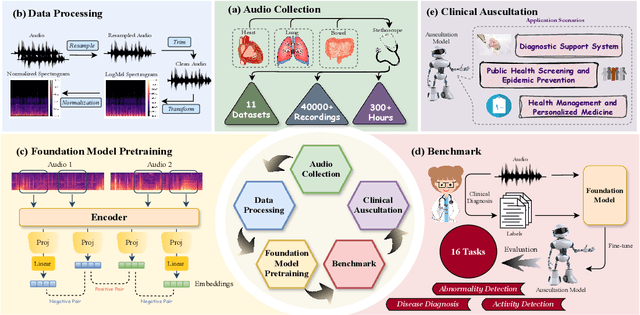
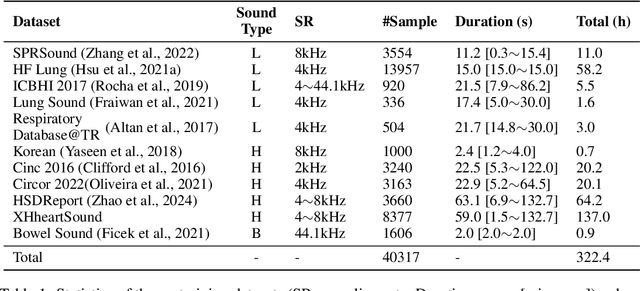
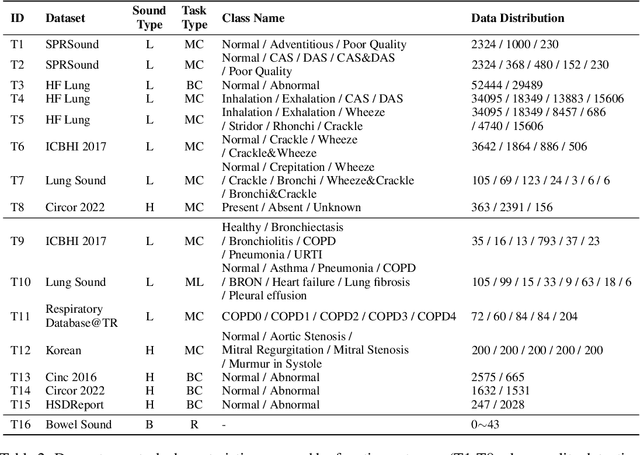
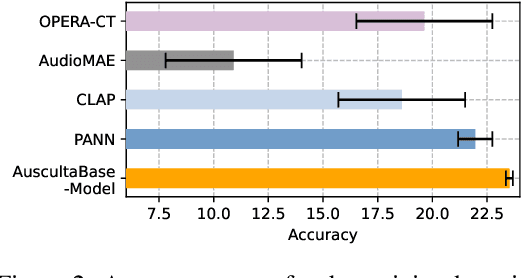
Abstract:Auscultation of internal body sounds is essential for diagnosing a range of health conditions, yet its effectiveness is often limited by clinicians' expertise and the acoustic constraints of human hearing, restricting its use across various clinical scenarios. To address these challenges, we introduce AuscultaBase, a foundational framework aimed at advancing body sound diagnostics through innovative data integration and contrastive learning techniques. Our contributions include the following: First, we compile AuscultaBase-Corpus, a large-scale, multi-source body sound database encompassing 11 datasets with 40,317 audio recordings and totaling 322.4 hours of heart, lung, and bowel sounds. Second, we develop AuscultaBase-Model, a foundational diagnostic model for body sounds, utilizing contrastive learning on the compiled corpus. Third, we establish AuscultaBase-Bench, a comprehensive benchmark containing 16 sub-tasks, assessing the performance of various open-source acoustic pre-trained models. Evaluation results indicate that our model outperforms all other open-source models in 12 out of 16 tasks, demonstrating the efficacy of our approach in advancing diagnostic capabilities for body sound analysis.
The Roles of Contextual Semantic Relevance Metrics in Human Visual Processing
Oct 13, 2024Abstract:Semantic relevance metrics can capture both the inherent semantics of individual objects and their relationships to other elements within a visual scene. Numerous previous research has demonstrated that these metrics can influence human visual processing. However, these studies often did not fully account for contextual information or employ the recent deep learning models for more accurate computation. This study investigates human visual perception and processing by introducing the metrics of contextual semantic relevance. We evaluate semantic relationships between target objects and their surroundings from both vision-based and language-based perspectives. Testing a large eye-movement dataset from visual comprehension, we employ state-of-the-art deep learning techniques to compute these metrics and analyze their impacts on fixation measures on human visual processing through advanced statistical models. These metrics could also simulate top-down and bottom-up processing in visual perception. This study further integrates vision-based and language-based metrics into a novel combined metric, addressing a critical gap in previous research that often treated visual and semantic similarities separately. Results indicate that all metrics could precisely predict fixation measures in visual perception and processing, but with distinct roles in prediction. The combined metric outperforms other metrics, supporting theories that emphasize the interaction between semantic and visual information in shaping visual perception/processing. This finding aligns with growing recognition of the importance of multi-modal information processing in human cognition. These insights enhance our understanding of cognitive mechanisms underlying visual processing and have implications for developing more accurate computational models in fields such as cognitive science and human-computer interaction.
Towards Fine-Grained Webpage Fingerprinting at Scale
Sep 06, 2024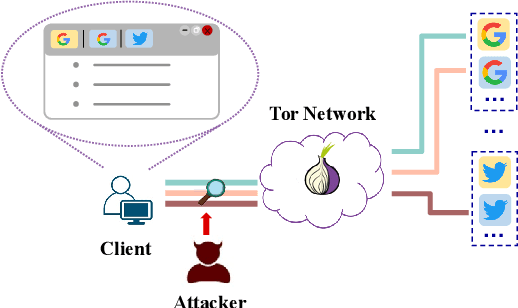
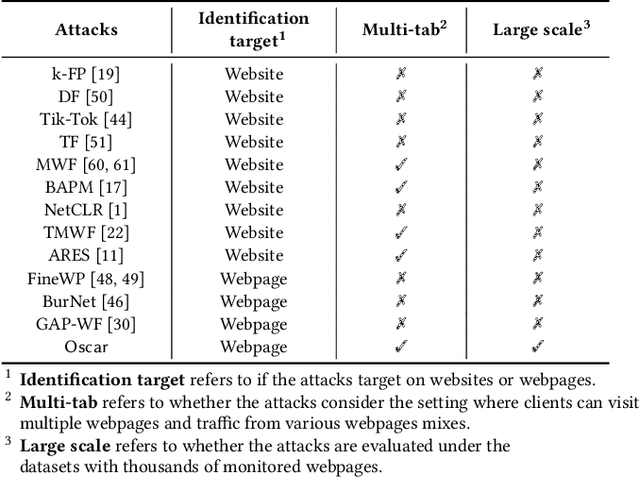
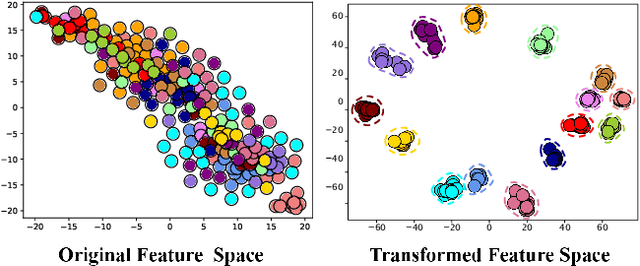

Abstract:Website Fingerprinting (WF) attacks can effectively identify the websites visited by Tor clients via analyzing encrypted traffic patterns. Existing attacks focus on identifying different websites, but their accuracy dramatically decreases when applied to identify fine-grained webpages, especially when distinguishing among different subpages of the same website. WebPage Fingerprinting (WPF) attacks face the challenges of highly similar traffic patterns and a much larger scale of webpages. Furthermore, clients often visit multiple webpages concurrently, increasing the difficulty of extracting the traffic patterns of each webpage from the obfuscated traffic. In this paper, we propose Oscar, a WPF attack based on multi-label metric learning that identifies different webpages from obfuscated traffic by transforming the feature space. Oscar can extract the subtle differences among various webpages, even those with similar traffic patterns. In particular, Oscar combines proxy-based and sample-based metric learning losses to extract webpage features from obfuscated traffic and identify multiple webpages. We prototype Oscar and evaluate its performance using traffic collected from 1,000 monitored webpages and over 9,000 unmonitored webpages in the real world. Oscar demonstrates an 88.6% improvement in the multi-label metric Recall@5 compared to the state-of-the-art attacks.
HSDreport: Heart Sound Diagnosis with Echocardiography Reports
Aug 16, 2024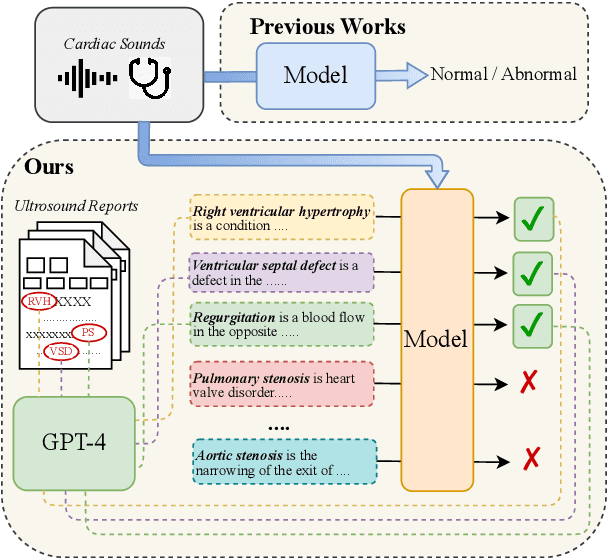
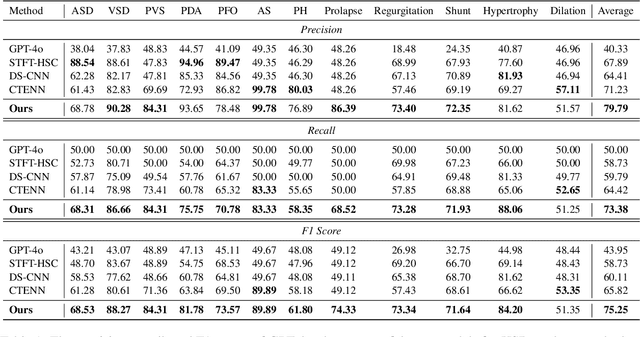
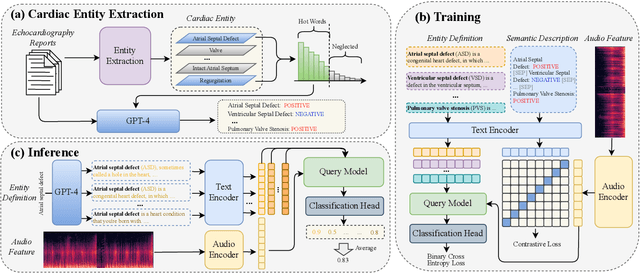

Abstract:Heart sound auscultation holds significant importance in the diagnosis of congenital heart disease. However, existing methods for Heart Sound Diagnosis (HSD) tasks are predominantly limited to a few fixed categories, framing the HSD task as a rigid classification problem that does not fully align with medical practice and offers only limited information to physicians. Besides, such methods do not utilize echocardiography reports, the gold standard in the diagnosis of related diseases. To tackle this challenge, we introduce HSDreport, a new benchmark for HSD, which mandates the direct utilization of heart sounds obtained from auscultation to predict echocardiography reports. This benchmark aims to merge the convenience of auscultation with the comprehensive nature of echocardiography reports. First, we collect a new dataset for this benchmark, comprising 2,275 heart sound samples along with their corresponding reports. Subsequently, we develop a knowledge-aware query-based transformer to handle this task. The intent is to leverage the capabilities of medically pre-trained models and the internal knowledge of large language models (LLMs) to address the task's inherent complexity and variability, thereby enhancing the robustness and scientific validity of the method. Furthermore, our experimental results indicate that our method significantly outperforms traditional HSD approaches and existing multimodal LLMs in detecting key abnormalities in heart sounds.
Prototype Learning Guided Hybrid Network for Breast Tumor Segmentation in DCE-MRI
Aug 11, 2024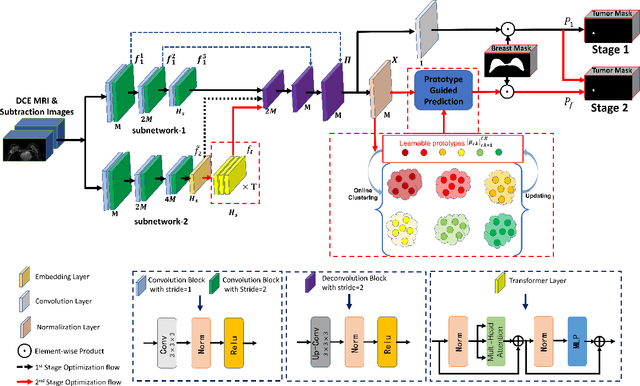
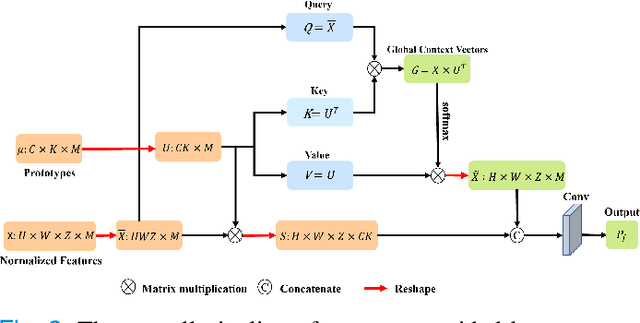
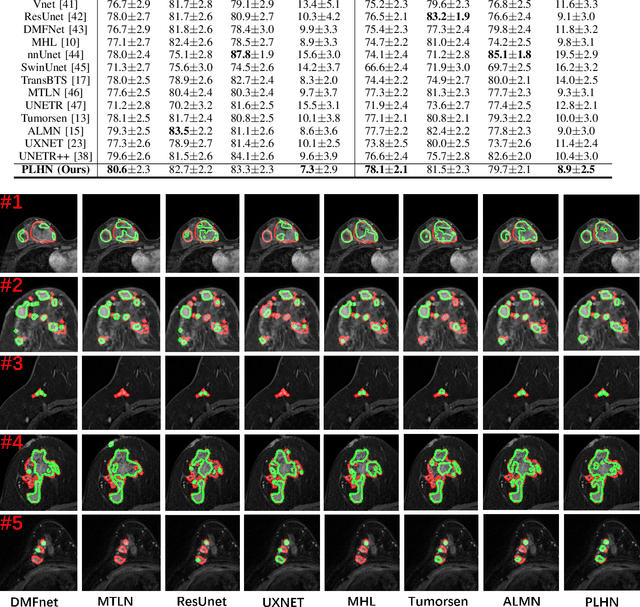

Abstract:Automated breast tumor segmentation on the basis of dynamic contrast-enhancement magnetic resonance imaging (DCE-MRI) has shown great promise in clinical practice, particularly for identifying the presence of breast disease. However, accurate segmentation of breast tumor is a challenging task, often necessitating the development of complex networks. To strike an optimal trade-off between computational costs and segmentation performance, we propose a hybrid network via the combination of convolution neural network (CNN) and transformer layers. Specifically, the hybrid network consists of a encoder-decoder architecture by stacking convolution and decovolution layers. Effective 3D transformer layers are then implemented after the encoder subnetworks, to capture global dependencies between the bottleneck features. To improve the efficiency of hybrid network, two parallel encoder subnetworks are designed for the decoder and the transformer layers, respectively. To further enhance the discriminative capability of hybrid network, a prototype learning guided prediction module is proposed, where the category-specified prototypical features are calculated through on-line clustering. All learned prototypical features are finally combined with the features from decoder for tumor mask prediction. The experimental results on private and public DCE-MRI datasets demonstrate that the proposed hybrid network achieves superior performance than the state-of-the-art (SOTA) methods, while maintaining balance between segmentation accuracy and computation cost. Moreover, we demonstrate that automatically generated tumor masks can be effectively applied to identify HER2-positive subtype from HER2-negative subtype with the similar accuracy to the analysis based on manual tumor segmentation. The source code is available at https://github.com/ZhouL-lab/PLHN.
 Add to Chrome
Add to Chrome Add to Firefox
Add to Firefox Add to Edge
Add to Edge